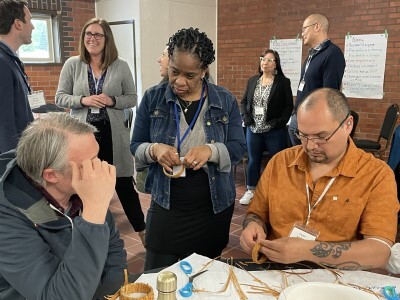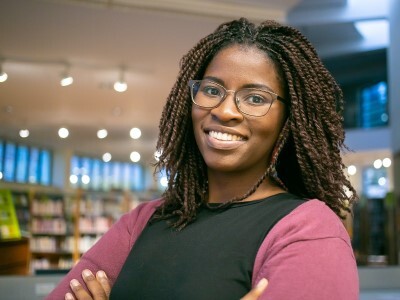Emancipatory Organizational Design: An Alternative to School and District Bureaucracy
Topics

Next generation learning is all about everyone in the system—from students through teachers to policymakers—taking charge of their own learning, development, and work. That doesn’t happen by forcing change through mandates and compliance. It happens by creating the environment and the equity of opportunity for everyone in the system to do their best possible work.
Eight characteristics of an "emancipatory organizational design" for school districts can move our school systems to ones that create coherence, equity, and powerful learning for students and adults.
“…we have lived for so long in the tight confines of bureaucracies… that it is taking us some time to learn how to live in open, intelligent organizations. This requires an entirely new relationship with information, one in which we embrace its living properties. In newer theories of the brain, information is widely distributed… And memories, it is now thought, must arise in relationships within the whole neural network. [I]nformation is stored in these networks of relationships…”
“To create better health in a living system, [then,] connect it to more of itself. When a system is failing, or performing poorly, the solution will be discovered within the system if more and better connections are created. A failing system needs to start talking to itself, especially to those it didn't know were even part of itself.”
–Meg Wheatley
In Part One of this piece, I asked if we were learning from the pandemic. While I noted the emergence of numerous new practices that could be amplified and help create a new, more learner-centered, more equitable system, I also noted the immense pressure across the educational system to return to the way things used to be. I explored why that was the case, concluding…
It is a tangled web of interacting systems that has withstood decades of efforts at reform. Even with all we’ve learned, these systems are stubbornly reasserting themselves so that a lot of supposed reinvention is actually just recreating the status quo. It is the frenetic energy and inertia of a system designed not to change.
Sadly, this “regression to the mean” has become even more pronounced in the two months since I wrote Part One. Students and teachers are suffering greatly as a result. Who is paying attention, and attempting a restart that is restorative, centers student and teacher health and wellbeing, engages student voice, focuses on racial equity, and emphasizes healthy relationships between staff and students? And who is seeing that as ongoing practice, not just a week at the start of school?
In my previous article on this topic, I critiqued this tangled web as inherently suffering from both a technical/bureaucratic worldview and a racist worldview that are the product of Western White supremacy culture. In contrast, dynamic learning environments, such as the kind of deeper learning described by Mehta and Fine, and Michael Fullan and his colleagues, involve an ever-deepening inquiry into what we are learning and how we enact that in our practice, at all levels of the system. Deep inquiry and dynamic learning environments could help us learn from the pandemic instead of pushing us to return to a system that was inequitable by design and wasn’t working for far too many young people and their teachers. This kind of dynamic and ever-deepening inquiry into learning (by students, by teachers) requires an emancipatory organizational design.
I am borrowing the term “emancipatory” from the work of Jürgen Habermas deliberately to make the point that neither a purely technical definition of learning (the Newtonian machine bureaucracy model that sees students as products) nor a professional/practical approach (that treats students like patients or clients) is sufficient for the kind of dynamic agency that deeper learning requires.
An emancipatory approach takes an ever-deepening critique of these technical and professional components. It also critiques the social constructs in which they are embedded (e.g., critical race theory is one approach to this kind of inherent critique) and seeks to respond to emergent agency on the part of students and adults alike. It then engages in an ongoing search for new purposes to support that agency.
An emancipatory organizational design is a series of fractals (that is, symmetrical forms at all levels) of what we want to see in the learning environment. Elmore believed that unless everything in the educational system surrounding the learning environment was coherently and symmetrically focused on supporting deep learning, then it would not happen. In the work we are doing in the Deeper Learning Dozen, we add that unless everything in the system focuses on a sustained and deepening inquiry—purpose seeking—into how to make that kind of learning happen for each and every young person and adult, it will not happen equitably. Thus the emancipatory organizational design provides for a symmetry of experience—equitable deeper learning—structured within and across the entire educational system.
An emancipatory approach and organizational design—an agile and nimble school and district organization—would center symmetrically on supporting the transformational work of equitable deeper learning, even during a pandemic. It would have the capacity to learn from what is emerging on the ground as effective new practice. It would be better prepared to respond to this urgent and immediate need for seeking a new purpose and finding new systems to enact that purpose (as opposed to the frenetic “hamster wheel” kind of urgency Mehta describes in his recent blog post). Such a system would recognize and become the fractals of the emerging learning experiences and be able to support them in an emancipatory way.
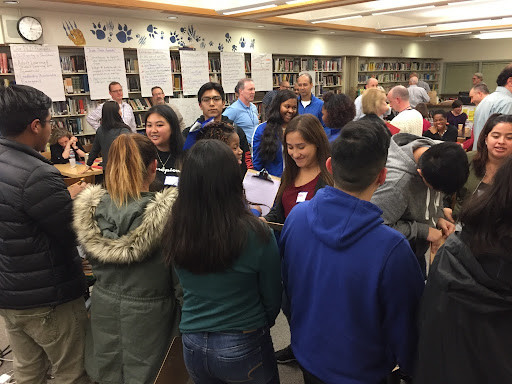
Oakland students lead a class for Deeper Learning Dozen district teams. (Courtesy of the author)
The Characteristics of an Emancipatory Organizational Design
What might be the characteristics of an emancipatory organizational design that symmetrically supports equitable deeper learning? In Part One of this blog post, I suggested some key characteristics. I will reiterate those here, and then elaborate on them and share some examples, ending with some of the many other possible metaphors that various organizational theorists have proposed. The characteristics are:
- Communities of Practice
- Dense Social Networks
- Simple Systems for Routine Tasks/Processes
- Evidence, Information, and Meaning Making Relevant to the Community
- Contingent and Emergent Systems
- Converging on Specific and Compelling Tasks/Processes
- Emergent Identities (Individual and Collective), Spaces for Learning, Connections, and Relationships
- Combining to Form New Organizational Systems as Needed
Communities of Practice
Communities of practice are effective in supporting both social learning and the spread of innovation and new ideas about teaching and learning. They are places where people come together around a shared passion to make a difference, establish an ongoing sense of personal and group identity, and create some protective but permeable boundaries around that identity and the vulnerable learning and emerging practice that is its purpose. In an emancipatory organization, communities of practice serve as each person's “home base,” whether those people are our young learners or all the adults in the system. Examples of student communities of practice that could support deeper learning include the EL Education “crew” or the advisories that are central to the design of Big Picture schools like The Met. Adult communities of practice should mirror these student forms. This is consistent with the work on growth culture, or “deliberately developmental organizations,” by Robert Kegan and Lisa Lahey. Tony Schwartz (Create a Growth Culture, Not a Performance-Obsessed One) describes a “growth culture” as including:
- “An environment that feels safe, fueled first by top leaders willing to role model vulnerability and take personal responsibility for their shortcomings and missteps.
- A focus on continuous learning through inquiry, curiosity and transparency, in place of judgment, certainty and self-protection.
- Time-limited, manageable experiments with new behaviors in order to test our unconscious assumption that changing the status quo is dangerous and likely to have negative consequences.
- Continuous feedback—up, down and across the organization—grounded in a shared commitment to helping each other grow and get better.”
Laura Flaxman, Robert Curtis, and Arun Ramanathan recently wrote: “In An Everyone Culture: Becoming a Deliberately Developmental Organization, Kegan, Lahey, and their co-authors… identified the key features of… organizational cultures and placed them into three interlocking categories: Home: a sense of community and trust; Edge: the challenge, development, and growth every employee needs to succeed; and Groove: the everyday practices, rituals, systems, and routines baked into the life of an organization.” Communities of practice address all three.
Every person in a school and district, whether a young person or an adult, needs a home base that serves as a place for shared passions about the work, a community and relationships that create a safe and trusting place for learning, and a place to develop and iterate their knowledge and practice together with others. Communities of practice have stable rituals and routines that support these needs. In these highly collaborative settings, people develop, iterate, and improve their practice. Recent writing by Etienne and Beverly Wenger-Trayner about what they are now calling “social learning spaces” defines these spaces in this way:
“a particular experience of engagement that takes place among people in pursuit of learning to make a difference… The term social reflects the centrality of relationships and interactions among people…. structured by a desire to push a joint inquiry together…. [in] a specific ‘enclosure of engagement’…. Their participation is not perfunctory or merely compliant but driven by their need to get better at making that difference… Participants engage with each other at the leading edge of their knowing how to make that difference…. [T]hey engage their uncertainty in the social learning space.”
Wenger-Trayner continue, “Viewing learning as value creation…. places the emphasis of learning on learners caring to make a difference rather than on knowledge, skill, or curriculum as commodities. It shifts the perspective from the inert to the living…. Learning to make a difference has to go through practice, where social learning reveals the value it creates through action.”
Isn’t the learning environment we truly desire one that is rich and fertile and biodiverse and welcoming of all our complexity, like an old growth forest?
Dense Social Networks
As I described in Part One, traditional schools and districts are organized in ways that can and almost always do very easily slide into rigid balkanized spaces of subject area departments, grade levels, divisions, offices, programs, and initiatives, with little to no communication between them, and with different, and often conflicting, visions, procedures, and reward and accountability systems for accomplishing the work. These organizational forms are meant to demand order and conformity. They aren’t designed for sharing information nor building effective and humane relationships, both necessary for the development of a shared sense of purpose and identity. They are definitely neither agile nor nimble spaces able to respond to the ever changing needs of learners. All of these dynamic human processes, however, are necessary for encouraging innovation and transformation.
The organizational design that most effectively supports the spread of innovation is communities of practice situated within dense social networks. “Dense” refers to the number of connections across communities of practice as well as the volume of flow of ideas and information through those connections. The challenge for organizational leaders is to keep communities of practice from becoming self-sealing and insular, support learning from “critical friend” interactions with others doing similar work, and encourage the identification and lateral spread of innovations that help the whole organization improve.
This is consistent with Fullan’s notion that system change (as opposed to just individual change) is driven by focusing on social capital development in collaborative learning spaces first. It is also consistent with David Albury’s ideas about scaling as more of a process of the ongoing proximity and thus interaction of different kinds of learning communities: communities of practice (pioneer innovators), nested within and interacting with communities of engagement (early adopters), similarly nested within communities of interest (people who want to keep informed about what is going on), where people experience each other’s work in an ongoing way. I will describe an example of this below in the section on Combining to Form New Organizational Systems. Wheatley and Frieze describe the leader’s role here as to notice, name, connect, nurture, and illuminate the work of these communities of practice. That happens in ever expanding dense social networks.
Network innovation and social learning theory and research (such as Murray and Millett, Vander Ark and Dobyns, and Lieberman and Wood) have shown that ideas develop and spread faster when well-resourced “nodes” of learners experience the following:
- They work in teams (organizationally-supported communities of practice),
- They have a sense of urgency around meaningful challenges, with what Ted Sizer referred to as “unanxious expectation,”
- They focus on those big challenges,
- They are connected in dense networks with lots of information flow, and,
- They get “critical friends” types of feedback from other nodes or teams in the network.
In addition, an orientation to network/social learning requires enacting these Principles of Social Networks:
- A highly distributed approach to leadership,
- A demand-driven and ever-expanding system to support that spread of learning,
- An organic approach to that growth, and,
- An overall system that is non-hierarchical.
This sounds a lot like Wheatley’s open and intelligent relationships within a highly distributed neural network. If you want a couple of great metaphors for the idea of dense networks, the research on starling murmurations (and more recently on midge swarms) and the notion of “near-criticality” in complex or chaotic systems (an emerging order that is not too loose and chaotic, nor too fixed and rigid), or the idea of distributed intelligences in interconnected sensor array networks, is quite intriguing. A positive example in human networks is the effect of guerilla gardening on the improvement of urban neighborhoods. Another, not so positive, example is the way in which illegal dumping in a neighborhood leads to increased crime in that neighborhood.
Simple Systems for Routine Tasks/Processes
Some routine work just needs simple ways to do it that don’t require much change over time. They just need to be the right systems to get the job done. That leaves most of our organizational energy for the deeper, more complex learning and practice development. Please note these are probably not offices with their own separate identities, cultures, value systems, and often not very permeable boundaries; they are more likely mapped patterns of process and work flows across different roles, of information, resources, or funds, designed to serve more complex work. Purchasing, or what outside of education is called supply chain, is one example. First response checklists for responding to crises is another.
These systems operate in what the Cynefin Framework literature refers to as the “simple domain,” where known technical solutions can be matched to known problems. However, even these systems can be improved over time if good feedback systems are built into how they operate. Doing that work takes us out of the simple and into the more complicated or complex domain of human identity, shared information, and effective relationships. An example of this kind of system improvement is improving purchasing so it actually supports teachers both affirmatively and efficiently. (A while back I wrote a rather caustic critique about how the lack of effective process mapping and an understanding of work flow, combined with a lack of a culture of supporting students and teachers, plague many purchasing departments in educational bureaucracies. Partly this is an artifact of the balkanization described above.)
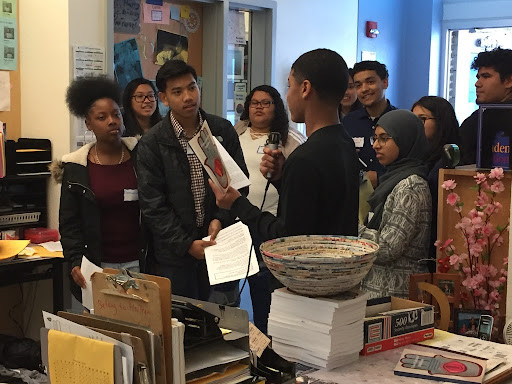
Oakland students present a cross-cultural medicine book they collectively wrote at a book reading. Local public health officials, UC Berkeley faculty, and doctors from Highland Hospital were among the audience that attended this demonstration of learning event. (Courtesy of the author)
Evidence, Information, and Meaning Making Relevant to the Community
“Student voice, multiple ways of knowing and learning, and community cultural wealth” as described by Shane Safir and Jamila Dugan in their book, Street Data, are foundational kinds of information/lifeblood that can be the basis of learning in the communities of practice, and the flow of information and ideas across the networks. How can we become mobilized and interconnected so we have access to these kinds of lifeblood?
Communities of practice need to ground their learning in shared information and evidence. Safir and Dugan advise us to use “street data” along with the “map” and “satellite” data we are more used to relying on. Using those data should involve the “radical inclusion” (Caroline Hill) of traditionally marginalized or silenced voices, such as directly involving low-income students of color and their families in “co-design” of the transformational practices we are developing. They describe “street data” thusly:
“Street data is a decolonizing form of knowledge that honors Indigenous, Afrocentric, and other non-Western ways of knowing. Street data emerges from human interaction, taking us down to the ground level to see, hear, and engage with the children and adults in our school communities—particularly those at the margins…. To that end we offer you three beliefs to guide your journey:
- Data can be humanizing
- Data can be liberatory
- Data can be healing” (p.19).
Beyond the data we gather, communities of practice need to ground their learning in collaborative analyses of that evidence. Cynthia F. Kurtz, in her book, Working with Stories, describes a process of participatory narrative inquiry that emphasizes “raw stories of personal experience; a diversity of perspectives and experiences; the interpretation of stories by those who told them; catalytic pattern exploration; and narrative group sensemaking.”
And in addition to gathering street data and engaging in collaborative analysis, communities of practice need to be aware that they go through developmental phases and cycles of learning. Each phase and cycle has a different emphasis, a different need for facilitation support, and creates a different kind of value to aid in accomplishing the community’s purposes. Wenger-Trayner discuss a range of these cycles where inquiry results in changes in practice that provide evidence of value creation of various kinds (as opposed to just seeking evidence of “student learning outcomes”) from immediate value, to potential value, to applied value, to realized value, to transformational value, that can focus and drive additional learning and practice improvement. Understanding these types of value creation might help take the pressure off educators, school boards, and policy makers to always be seeking the next perfect test of student learning outcomes.
The kinds of inquiry that I think are at the heart of the deeper learning and increasingly equitable learning spaces we want to create, both for young people and for adults in our schools and districts, all require different assumptions and habits of mind and heart about what counts as evidence and how we go about gathering and using that evidence in the service of equitable whole organizational learning and transformation. The challenge, then, is how we will use this expanded notion of evidence in support of that transformation. Most likely this will involve nested and iterative cycles of inquiry “from the classroom to the board room,” across schools and districts. And then what we often think of as fixed systems and infrastructure need to change to become dynamic enough to support transformation. I discuss those next.
Contingent and Emergent Systems
Communities of practice are the home bases that will grow and develop organically and over time as their members’ passions, purposes, knowledge, skills, and practices grow and develop. However, the networks they exist within, and the ways that members will need to come together across communities of practice to work on specific tasks, must be emergent, contingent, and mutable. The networks must be based on purposes that emerge from members’ ongoing analysis of the evidence of the needs for student learning experiences and teacher pedagogical development. This should be true of how students come together to pursue their deepening learning inquiries as well.
If...
- a need is identified through collective evidence gathering and sense-making,
- a community of practice is learning together how to develop practice to address that need, and,
- their ideas and ways of working are spreading across a dense social network...
Then an agile and nimble school and district system should develop the systems and infrastructure to support that effort. This includes time, space, and resource allocation, that support enactment and iteration of those emergent practices into their improvement, as well as getting other existing systems that are barriers to enactment out of the way. And then when those systems and infrastructure are no longer needed or serving their intended purposes, to “hospice” them. We do not need to continue the “geological residue of generations of other people’s ideas about what schools need to do,” as Richard Elmore said.
A fine example of this kind of emergent system is embodied in the Kettle Moraine School District in Wisconsin. Now-retired superintendent Pat Deklotz worked with the board, her colleagues, her students, and her community for years to create an inclusive community-wide and ongoing planning process. Over time, nested within clear values and community wishes for student learning, they created a “culture of yes.” Pervasively across the district, people in leadership roles and teachers approach their work by starting every conversation about a request to try something with “yes, we can do that,” followed by, “now let’s sit down and figure out how.” In addition Deklotz led the way to a culture that celebrates failure as necessary along the path of learning. One principal I met starts every speech he makes by admitting to his audience that 90 percent of the time he tries something new, he fails. This culture of risk taking in learning at Kettle Moraine pervades both adult and student learning as well as emergent and contingent systems to support it.
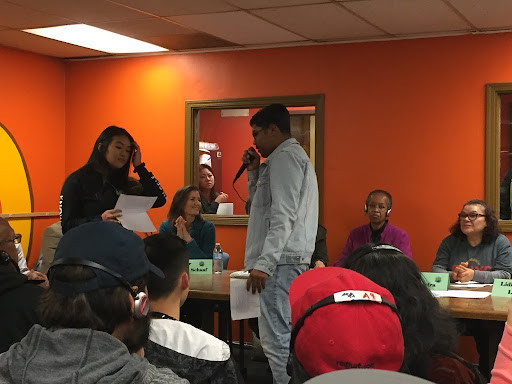
Oakland students present their research about community determinants of health and illegal dumping to the city's mayor, along with a list of demands. (Courtesy of the author)
Converging on Specific and Compelling Tasks/Processes
“In open systems [all human systems are open systems, in that they take in energy from the surrounding environment, use what they need to maintain or grow themselves, and the excrete waste energy back into the environment], in far from equilibrium states [where new systems and infrastructure are being created to serve emerging purposes and needs, thus where transformation is happening], new orders emerge spontaneously.” –Prigogine and Stengers
There is a great series of graphic images from the field of complexity theory called “strange attractors,” originally developed by Edward Lorenz. I use one of these images, called the “three winged bird” to represent the strange attractors in organizations that people gather around to discuss, and then to create shared meaning and practice, in this case about values, community, and accomplishments. But there are plenty of others. The story I told in Part One about the environmental sciences academy that wanted to redesign their program of study was about a strange attractor for the academy teacher team, the district pathway coach, and the science curriculum specialist. In Vista Unified School District, outside San Diego, the district supports the formation of “sprint teams,” strange attractors of specific, time-bound projects that aid in the overall district transformational effort, that attract people from across schools and roles who want to work on them together.
These convergences around specific tasks and learning related to them need to remain always open to emerging, dissolving, or transforming, agilely and nimbly, as new purposes emerge from a student’s, a teacher’s, a school’s, or a district’s inquiry and learning. Because there will always be many more than one strange attractor in a school or district, there is a wonderful kind of “wobble-i-ness” that accompanies them, and so the organization that emerges needs itself to be more wobbly and less fixed and determinant. These convergences emerge and disappear, people move from one to another as their sense of purpose and passions change. And once again, they need to transcend traditional school and district boundaries.
Part of the role of leaders, then, is to watch these strange attractor groups forming and dissolving and guide them and also hold the space so that they can serve the overall vision of the district. But that role should be held lightly, because the leader may not always know exactly what might emerge from their wobbly existence and interaction. That is, “wobble-i-ness,” and the patterns that emerge from it, are indeterminate.
Emergent Identities (Individual and Collective), Spaces for Learning, Connections, and Relationships
Every time a new group converges on a new strange attractor, a new opportunity emerges to move from “I” to “We” and from emergent purposes to emergent work, learning, and new practice. Consequently, schools and districts need space and time to develop new individual and collective identities. They also need to create spaces, connections, and relationships in order to engage in those new exchanges of ideas and information, new meaning making, and new practice development. And these new spaces for shared identity development and emergent work require new boundaries. Those boundaries require attention and care (by members, by organizational leaders) in making sure they are solid enough to protect the creation of shared meaning and the safe emergence of new practice within the emerging group, but permeable enough to assure the ongoing flow of ideas, information, feedback, and the illumination and championing of their new practices across the larger networks.
District leaders want these emergent groups to feel efficacy and interdependence and to be effective in what they form to accomplish. Teachers who want their students to come together in teams to work on compelling problems must address the challenge of supporting team identity to form out of the individual identities of very different students. In one case I know, a community mapping activity that was a part of a unit on social determinants of health turned up evidence of huge disparities in the amount of illegal dumping depending on whether it was in a low-income neighborhood of mostly people of color or a higher income neighborhood of mostly White people. This disparity incensed the students so much that they dove into a research effort supporting a community action project in collaboration with several community groups. Students then presented their research and their demands for action to the mayor. If the teachers involved had not made the effort to pause what they thought the unit was about, guide the team formation, open up the space in their curriculum for the new learning to emerge, and support the connections and relationships to form within the teams and with the community action groups, none of this powerful experience and learning could have occurred.
Combining to Form New Organizational Systems as Needed
New organizational systems operate in the complex space of a different orientation to “the way things are,” and we should use them to support a liberatory and humane pedagogy for our children and ourselves and for our future generations. Certainly emergent practice can become established practice through the iteration of reflection on how well it achieves the purposes we have for it, though I don’t think I know a good teacher who ever thinks their practice has become perfect. Once practice becomes established and is serving its intended purpose, the leader’s responsibility is to bring collections of practices into shared public discourse—that is, knowledge and practice held lightly and dynamically in the social learning space, as Wenger-Traynner describe it, not an inert and fixed commodity like an adopted curriculum. Leaders can support evidence gathering, sense making and iterative cycles of improvement around these collections of practices, and then they can create the systems and infrastructure to support them.
An example I saw play out in a small school in Oakland involved an emerging vision among staff. They envisioned becoming a college and career pathway, with a series of related projects across the grade levels that led to and culminated in a graduate capstone project and performance assessment. Most of the grade-level teams had been working on student projects, but these were not aligned with either the pathway theme or the imagined capstone. A ninth grade team, however, was passionate about developing such a project, and the school administration gave them the time and resources to get to work on it. One condition was that every month they would present their developing work to the rest of the staff in a “critical friends” consultancy or tuning protocol. The leadership team was deliberate in having the ninth grade team share their work not as examples of best practice but as work in progress that needed helpful feedback from the other grade-level teams. In this way, the other teams wouldn’t feel that their work was inadequate, and they would see that they were helping the ninth grade team with crucial feedback. In addition, as David Albury describes it, the ninth grade team, as a community of practice, was able to spread interest and enthusiasm for their innovative work to others who might not be quite ready to take that risk (as a community of engagement), but could slowly come to see that it was possible to develop their own versions of it.
This is a process that Kevin Kelly refers to as “controlling from the bottom-up,” and “chunking,” functions that are specific to network organization and learning. It achieves system-wide coherence in a very different way from that which we suppose we can get by purchasing and then mandating a new curriculum or test from the top down. As I said above, though, these larger systems must always remain self-aware, self-reflective, and able agilely and nimbly to change or dissolve in order to support the constantly changing environment and ever-deepening inquiry and learning of each and every one of our young people.
Metaphors for the New Organization
If we are looking for metaphors of a different way of organizing schools and districts from the traditional machine or professional bureaucracy metaphor, many exist:
- Gregory Bateson developed early systems theory ideas about circular feedback systems rather than linear causality, and ways that human communities maintain equilibrium, from watching storytelling in Indigenous cultures in the South Pacific.
- Prigogine and Stengers took images from open systems, thermodynamics, and complexity theory.
- Edward Lorenz, as I discussed above, developed the idea of “strange attractors” for how patterns of ways of doing things begin to emerge and coalesce unpredictably in complex spaces.
- Maturana and Varella, and later Fritjof Capra (both described in Burke), thought the energy flows (identified as patterns, processes, and structures of organizations) and self-replication of natural forms (such as what they referred to as the “autopoiesis” evident in cell functioning) could provide useful ways to think about human knowledge creation and self-replicating human systems like our “post-pandemic” school districts hell bent on getting everything back to a “normal” that never was.
- More recently, Wagter and Russell have described opening up our images of system building blocks beyond the traditional organization chart to include nodes and flows of information (as in the ways that innovating networks operate).
- And Chris Corrigan describes the ways that all of these—attractors, identities, boundaries, connections, and exchanges—can combine to form new organizational systems that operate in the complex space of our current global learning needs.
- There are many Indigenous epistemological frameworks and resulting organizational models (cultural or community structures, methods of communication and decision-making, rich ideas about learning embedded in place, experience, and storytelling) that are circular in process and web-like in the overall image of how the world is structured.
- A number of pan-African epistemological world-views are “rooted in spirituality, communalism, cooperation, ethics, and morality” (Safir and Dugan, quoting Bakari).
The list goes on and on, opening up possibilities for reconceiving organization beyond just the Western bureaucratic and hierarchical image, but few of these ideas have penetrated educational organizational thinking or actually changed “the way we do things.”
The images I described above of a more dynamic, complex, emergent learning environment require a complex and emergent organizational form, one that continuously learns and evolves as the learning environment does, one that is agile and nimble, one that innovates rapidly in response to emergent learning needs. Shane Safir describes that organizational environment this way: “In a sense, this is an ecological project. We have over-farmed the land and undernourished our students and educators while failing to water the roots of a healthy system: student voice, multiple ways of knowing and learning, and community cultural wealth.”
This perspective moves us from the Newtonian metaphor of the control of machines toward the metaphor of the gardener, but even that assumes too much control and ordering of experience, too much regulation of the system, and even a kind of agribusiness orientation to how to make plants grow well. It's individualistic and deterministic: individual plants in rows, given appropriate measures of nutrient inputs and artificial pest controls, similar to our tradition of rows of desks in a classroom and the banking model of learning. The gardener metaphor does not necessarily frame the garden space as an ecosystem of complex interacting factors. The rewilding movement in Scotland seems closer to what we want.
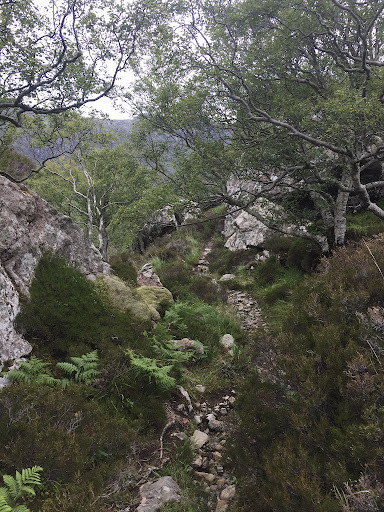
Rewilding in Scotland. (Courtesy of the author)
Rewilding protects and stewards new spaces where biodiverse native forests can regrow, as opposed to the regimented monocropped straight rows of same species in industrial forests the Scots grew a century ago for militaristic and immediate economic purposes. Cheryl Ka‘uhane Lupenui and Gary Chapin wrote about natural ecosystems as a metaphor for educational reimagining. So, perhaps a better metaphor would be stewarding an ecosystem, or possibly just creating a safe space where the “rewilding” of education might occur. All of these are part of trying to break free of the overly rigid rules and mindsets that in our more traditional systems have ended up restricting thought, play, invention, and growth, not to mention denying a sense of belonging and worth to so many of our students and families. Isn’t the learning environment we truly desire, instead, one that is rich and fertile and biodiverse and welcoming of all our complexity, like an old growth forest?
In Conclusion
As I concluded in Part One, these key characteristics for an alternative organization, and the freedom it might allow, are not a territory for the faint of heart. It will take great leadership courage to create and sustain such an organizational territory. And none of this can be imagined if we can’t get the metaphor of the machine bureaucracy and the command and control hierarchy of value and worth out of our minds, and imagine a more humane, equitable, dynamic, biodiverse ecosystem of learning and development in its place. Peter Senge offers a way forward for the courageous leader: “The essence of the role will be the [leader] as researcher and designer. What does she or he research? Understanding the organization as a system and understanding the internal and external forces driving change. What does she or he design? The learning processes whereby managers throughout the organization come to understand these trends and forces.” Are we ready to make this future compelling?
Photo at top by Brodie Vissers.



